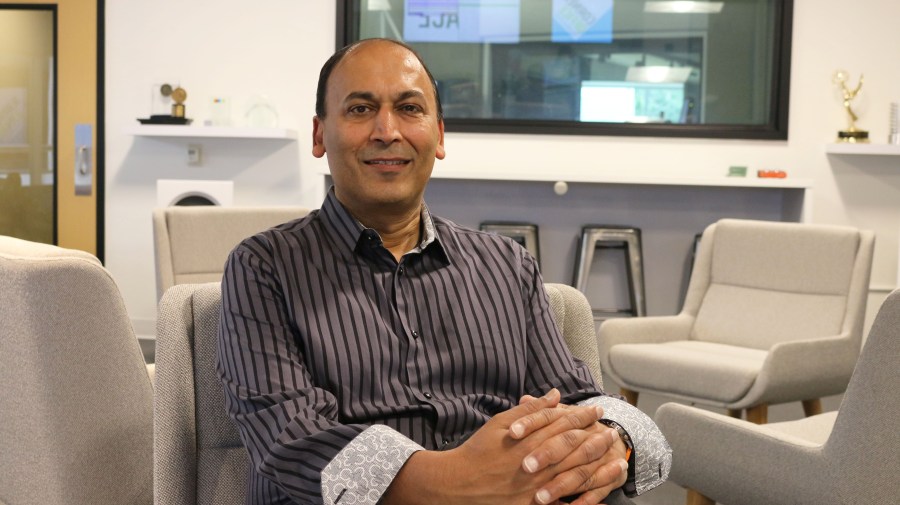Poshmark’s Manish Chandra talks resale at scale

Those of you who are really into the retail resale business have probably heard of Poshmark.
For those who haven’t, Poshmark is an app where you can either buy items from other users or try to sell unwanted items like clothes, handbags, shoes, or home decor. Think of eBay, but with social aspects, where people can follow each other’s “closets” and comment or share the listings they like.
The social shopping app started in 2011 and now has 50 million users. Active users engage with the app between 23 and 27 minutes a day. Marketplace host Kai Ryssdal recently spoke with Manish Chandra, Poshmark’s co-founder and CEO.
The following is an edited transcript of their conversation.
Kai Ryssdal: Why, or how, did you decide that social was the way to go with this company?
Manish Chandra: I had started a company before called Kaboodle, which was really all about a social community centered around fashion. You couldn’t buy and sell, but you could share. Sort of like a modern-day Pinterest. I discovered, through that, that social was really the foundation for how fashion should be bought and sold. Of course, that product didn’t have it. So when we started the next journey, we wanted to create a social platform, but we also wanted to make it very easy to post things and create things. When the iPhone 4 came out in 2010, we finally found a platform that was sort of the trigger. And today, of course, we do everything on our phones. But seven to eight years back, it seemed like a big leap of faith.
Ryssdal: There’s no small irony in me asking this question, wearing, as I am, a set of khakis and — I don’t even know what shirt I have on today. Why and where did fashion come from, for you? I mean, you’re nattily dressed. But where did that come from?
Chandra: Well, I spent first 15 years of my life in technology. I built databases, database software, I was part of a couple of public companies. And as we were remodeling our home in 2003/2004, I started to realize that the process of shopping for the products was really hard. And from there, started my first company, Kaboodle. And we quickly found that the product market fit was highest in fashion. That company was acquired by Hearst. I spent a couple of years working with a lot of the Hearst Magazines — Cosmopolitan, Seventeen, Marie Claire — and in those 5 years I sort of had the proverbial “10,000 hours” of fashion experience and sort of got really excited about fashion and community.
Ryssdal: That community, then. Talk to me about how — this is a straight-faced question — how do you make money off your community?
Chandra: We simply partner with them. So, we take 20% of every transaction that happens on the platform and they keep 80%. For smaller transactions, $15 [and under], we have a fixed fee [of] $2.95 — and that’s it. That’s all in. We don’t have any marketing cost, there’s no other sort of overhead, it includes credit card processing and the buyer pays for shipping. So it’s a fairly simple model.
Ryssdal: To be clear, these are — at least, for the start of this company — these were used clothes, people emptying out their closets.
Chandra: Yes, even today 70% of the clothing is used, 30% is new. And they’re sold by our 5 million sellers who are really everyday people who decided to, sort of, engage in this process of buying and selling.
Ryssdal: I read somewhere that you credit Marie Kondo and her, you know, “declutter your life” craze, for helping you out a little bit, people emptying their closets.
Chandra: Yeah, Marie Kondo was definitely a factor, this year. But the business has been growing very nicely for seven to eight years. And today, I feel like, reselling, this sort of whole collaborative economy, is really mainstream. You know, we take car sharing, we live in shared homes when we travel and we buy and sell clothes. It has a pretty major impact in both the world of retail and, sort of, [the] social front.
Ryssdal: You’re of some scale now, right? You’re a billion-dollar company now, right?
Chandra: Yeah, we did announce last year that we have distributed over a billion dollars to our seller stylists.
Ryssdal: Right. Talk to me, then, about growth because, as you know, it can be treacherous scaling too fast. Look at – Etsy is the example that everybody cites – Etsy has run into some trouble.
Chandra: Yeah. And in the very early days, back in 2012, 2013, we scaled too fast. And in those times, we had to really cut back our growth, but then we created a solid foundation. We have, you know, invested in technology infrastructure, people infrastructure, shipping infrastructure, dispute management infrastructure, and so the business, at this point, is really powered by people and technology, and continues to scale. We have expanded it to home decor, we expanded it beyond women’s fashion – a few years back, to men’s and kids – and we’ll be broadening ourselves out to the international markets. We just took a small step in in Canada and opened up our offices in Canada to serve that community.
Ryssdal: Who’s your competition, then? I mean, I’m thinking of The RealReal with Julie Wainwright who just went public, right? We had her on the program. Do you look at them and say, “hmm”?
Chandra: Sure. So, I think a lot of reselling marketplaces, including The RealReal, are definitely part of our competition. They focus primarily on a very specific segment, which is luxury. We cater very broadly. But then also, sort of old marketplaces, like Amazon and eBay, are indirectly competing with us. As well as, what you see is a lot of physical retail now starting to either partner or get into the world of resale.
Ryssdal: There’s a pop culture element of fashion that you sort of have to be on top of. Are you?
Chandra: You know, if you’d asked me that question 10 years back, I would have said probably no. Today, very much so. In fact, you know, sometimes I surprise even my grown-up kids in terms of how much I know about stuff. It’s pretty funny.



















